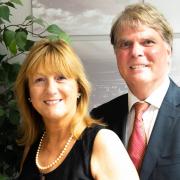Japan and the US each have more than 40 MRI scanners per million people. Developing countries typically have fewer than two, signaling huge expansion potential for Eynsham-based Siemens Magnet Technology. Nicky Godding spoke to CEO Craig Marshall to find out more.
The first body scan using MRI technology was done in 1977. It took five hours to produce just one image but it was the
pinnacle of achievement for its inventor, Raymond Damadian, an American of Armenian origin. Nearly 40 years’ later magnetic resonance imaging is still medicine’s most powerful and reliable diagnostic tool and more than a third of all MRI scanners installed in hospitals around the world have at their heart a superconducting magnet designed and manufactured by Siemens Magnet Technology at Eynsham, the world leader in their design and manufacture.
Heading up this company, which employs several hundred people and is based on a purpose-built 190,000 square foot facility in rural Oxfordshire, is Craig Marshall.
Sometimes you never know where ambition will take you, and talking to Craig the phrase ‘the best laid schemes of mice and men’ comes to mind. Craig graduated as a mechanical engineer from Liverpool University, perhaps dreaming of a glittering career applying his technical, scientific and mathematical knowledge and ingenuity to personally develop solutions to improve the lot of mankind.
Only life didn’t quite work out like that.
After a year in London post graduation, in an engineering job that was far from stimulating, he moved to Oxford Instruments in 1985, at that time perfectly poised to exploit the MRI revolution.
“I spent my first 10 years as an engineer, but realised after a few years that though I was a reasonable engineer, I was never going to be a stellar one,” he said. It was a painful personal acknowledgement, but what Craig had spotted was that among his peers he was far stronger in areas where they were weak: in people skills and administration, vital elements of management that he was to deploy effectively years later.
“Some great engineers I have known have never moved off first base in a managerial context because they don’t tackle administration properly. Sometimes they can’t even fill in the forms to get a new company car, but they are much better
engineers than I ever was.”
It’s tough to have to critically reassess your future career when you’ve been so focused on a future that all of a sudden
seems unreachable, but Craig’s approach was pragmatic. By that time Oxford Instruments had established Oxford Magnet Technology, a subsidiary of the main business in its brand new purposebuilt facility at Eynsham, and he went back to school. Well, not exactly: he spent five years completing an MBA, sponsored by his company but completed in his own time.
He achieved a distinction.
By this time Oxford Magnet Technology, still owned by Oxford Instruments, had entered into a joint venture with Siemens, which went on to acquire the business in its entirety in 2003. Craig became a project manager, first in Germany and then in the UK. He returned to Eynsham after three years to manage High Field Open, a project to create the first open access magnet to deal with claustrophobia felt by many patients in the first generation, tightly fitting MRI scanners.
“Technically the project was successful,” explains Craig. “But it was expensive to manufacture and solenoid magnets (the coils inside the machine) were getting shorter.” As a result patients’ heads did not have to be encased in the machine for the majority of examinations, which largely dealt with the issue of claustrophobia.
Craig had completed his MBA at this stage, but he was still not a manager and had itchy feet for the next promotion. “I’d been in the business for 16 years, had a bit of post MBA syndrome and thought I could conquer the world.”
He left Siemens to strike out and gain wider experience, first at Oxford Instruments working on key accounts, moving after just a year to work directly for one of those accounts, Amersham plc, a FTSE 100 company. “It was job I really enjoyed, working much closer to the clinical space and managing a project quantifying the rate at which the brain shrinks.”
Then a career decision came hurtling towards him. He loved his job at Amersham, which by that time had been taken over by GE and become GE Healthcare, but was invited to return to Siemens Magnet Technology to fill the role he’d always coveted: Engineering Director.
“I said no. I was having too good a time at GE Healthcare and had been promoted to line manager.”
But with his wife and three daughters still living in Oxfordshire, and a long daily commute to Amersham, at the eleventh
hour he changed his mind. The only trouble was, rather than walking into the job, he now found himself having to compete for it with others.
“It was better in the long run as when I did return, I had to do it through a transparent recruitment process.”
Craig had finally achieved a role where not only were his engineering skills put to good use, but his management skills were being deployed properly.
“My key contribution in this role was to put in some clear thinking. The engineering group needed to do three things: to
maintain today’s products, which includes driving quality up and costs down and to plan for tomorrow’s products, having a
product road map and a corporate commitment that these products will get made. Beyond that is future aspiration where we look seriously at emerging opportunities. This is how NASA organises its technological development and we’ve customized its ideas to work here. Simon Calvert, my successor as engineering director has taken this concept and made it more sophisticated, but the principles are still the same and it’s serving the business well.”
So well, in fact that Craig became managing director in 2010, the first British man to do so since Siemens acquired the remaining 49% of the business from Oxford Instruments in 2003.
Now, rather than using his technical skills in the design and development of products, he’s using his analytical engineer’s brain to get the most out of his staff.
“Leaders lead primarily from the heart. It’s emotional and then it’s cognitive. Management is the other way around. As a
leader, I don’t need to have the big idea, it’s great if I do, but actually what’s more important is that I spot and sponsor great ideas in others. A boss’s job is to shut up and listen.”
Surprisingly he also says that part of his job is also to be vague. “Vagueness is an interesting concept. I won’t accept vagueness in my management team and expect them to be clear, specific and intolerant of vagueness in their teams.
However, as a leader I can describe in vague terms what we are going to be doing at the end of the decade and that’s fine because visions can be vague, it’s called strategic vision. Relax and embrace vagueness.”
Good leadership is also about being seen and heard by all his staff. He does a monthly employee company update on the shop floor, including talking to the weekend shift workers, and hosts a monthly breakfast meeting with 20 staff members at a time. “The company update is a monologue, but the breakfasts are a dialogue,” he says.
Craig is clearly passionate about life long education and over the past two years has combined an interest in philosophy with management and leadership thinking to get the best out of people for business success.
So having reached the top in a worldclass business, what is his own future likely to be? Outside work, Craig’s interests include sailing, fishing and painting watercolours, but he’s not quite ready to settle down to a life of ease yet.
“In five years time I’ll be 57 and would hope to be still within this wonderful industry, but probably in a different capacity. Ten years as a managing director is probably enough. There will be better people with new ideas.
“I would like to complete my career in a business school, sharing some of the experience I’ve gained over my career: The engineering of people. If I can’t do machines I can do people.”
World leading design and manufacturing
Siemens Magnet Technology is the world’s leading designer and manufacturer of superconducting magnetic resonance imaging magnets for medical applications.
At its award-winning Eynsham manufacturing facility, research and development teams work alongside their colleagues in lean manufacturing production. Around 95% of the magnets produced at Eynsham are exported and the business has been awarded several Queen’s Awards for export success.
More than 30% of the MRI scanners installed in hospitals worldwide have at heart a superconducting magnet manufactured by Siemens Magnet Technology.
Are graduates promoted too early?
Craig says: “Graduate engineers have technical skills but many have little management knowledge. Increasingly in some businesses I see them being promoted to managers or line managers in charge of important, experienced employees sometimes just a year or two after joining a business. But in my opinion, people skills can only be gained through experience. For me that journey took 25 years and I am glad it did. If it had only taken 10 or 15, I couldn’t have cut it.”
-----------------------------------
This article is from the May 2015 issue of Business & Professional Life



























